Experimental Investigation on Fracture Behavior and Mechanical Properties of Red Sandstone Subjected to Freeze–Thaw Cycles
Abstract
:1. Introduction
2. Materials and Methods
2.1. Samples and Mineral Compositions
2.2. Test Schemes and Instruments
2.3. Physical Property Measurement
2.4. SEM Tests
2.5. Freeze–Thaw Cycles Procedure
2.6. Mechanical Property Tests
3. Results
3.1. Mass, Volume, and Bulk Density
3.2. P-Wave Velocity
3.3. Typical Stress-Strain Responses
- The fracture surface closure stage: In the closure stage, the stiffness of the fracture surface is less than that of the rock mass, thus mainly resulting in the occurrence of fracture closure during the first stage.
- The quasi-elastic stage: In the quasi-elastic stage, the deviator stress versus axial (or lateral) strain curve appears to ascend.
- The stable propagation stage of new cracks: Since the bonding strength of the fracture surface is much less than that of the rock mass, new fractures start to initiate and develop along the original fracture surface during this stage; in other words, the fracture surface starts to debone.
- The unstable propagation of new cracks: During the unstable stage of new fracture initiations, most of the original fracture surfaces start to debone and crack, which is manifested in the process of the loss of bonding strength of the original fracture surfaces. During the stage of new fracture development, in addition to the loss of bonding strength of the original fracture surfaces, the damage of the rock mass originating from the initial fracture surfaces is also accompanied by the occurrence of adjacent new fracture surfaces. The new fractures gradually coalesce and eventually become inter-connected. That is, the overall strength of the fractured rock mass is lost, and ultimate failure occurs.
3.4. Mechanical Parameters
4. Discussion
4.1. Microcracks Propagation
4.2. Failure Modes
5. Conclusions
- (1)
- The mass, volume density, and P-wave velocity of the red sandstone show a significant correlation with the number of freeze–thaw cycles. After being treated by freeze–thaw cycles, the mass, density, and P-wave velocity of rocks decrease, while the volume of rocks increases. The variation trend of mass, volume, density, and P-wave velocity of rocks show linear correlations with freeze–thaw cycles.
- (2)
- The mechanical properties of the red sandstone are highly influenced by the freeze–thaw cycles and confining pressures. The peak stress and elastic modulus are decreased with the increase in freeze–thaw cycles, while peak strain and Poisson’s rate are increased. Results also show that the confining pressure significantly influences the mechanical performance of rocks, while the freeze–thaw cycles influence the deterioration of the mechanical performance of rocks.
- (3)
- After being treated by freeze–thaw cycles, the number of micro-cracks and pores within the saturated rocks increased. The frost heaving stress induced in the freezing process drives the propagation of micro-cracks and the generation of new micro-cracks. The micro-structural changes in rock determine its macroscopic mechanical behaviors, such as deformation, strength, and failure mode.
- (4)
- Before freeze–thaw cycles, red sandstone presents a typical brittleness feature since the failure mode shows single or multiple macro-cracks that develop along the axial direction. However, when confining pressure is applied, the rocks subjected to freeze–thaw cycles show more and more ductility characteristics, and the failure modes gradually transfer from splitting to shear.
Author Contributions
Funding
Institutional Review Board Statement
Informed Consent Statement
Data Availability Statement
Conflicts of Interest
References
- Treat, C.C.; Jones, M.C.; Alder, J.; Sannel, A.B.K.; Camill, P.; Frolking, S. Predicted Vulnerability of Carbon in Permafrost Peatlands with Future Climate Change and Permafrost Thaw in Western Canada. J. Geophys. Res. Biogeosci. 2021, 126, E2020JG005872. [Google Scholar] [CrossRef]
- Obu, J. How Much of the Earth’s Surface is Underlain by Permafrost? J. Geophys. Res. Earth Surf. 2021, 126, E2021JF006123. [Google Scholar] [CrossRef]
- Wu, C.; Deng, R. Research on the Extraction Technology of Gas-Integrated Working-Face in Close Coal Seam Mining in Permafrost Area. Geofluids 2022, 2022, 2379040. [Google Scholar] [CrossRef]
- Gong, S.; Wang, W.; Xi, F.; Shen, W. Investigation of Dynamic Mechanical Properties of Coal after Freeze-Thaw Cyclic Conditions. Geofluids 2021, 2021, 8602301. [Google Scholar] [CrossRef]
- Qi, X.L.; Xu, H.J.; Chen, T.; Shan, S.Y.; Chen, S.Y. Effects of climate change, coal mining and grazing on vegetation dynamics in the mountain permafrost regions. Ecol. Inform. 2022, 69, 101684. [Google Scholar] [CrossRef]
- Kraev, G.; Belonosov, A.; Veremeeva, A.; Grabovskii, V.; Sheshukov, S.; Shelokhov, I.; Smirnov, A. Fluid Migration through Permafrost and the Pool of Greenhouse Gases in Frozen Soils of an Oil and Gas Field. Remote Sens. 2022, 14, 3662. [Google Scholar] [CrossRef]
- Li, X.; Jin, X.; Wang, X.; Jin, H.; Tang, L.; Li, X.; He, R.; Li, Y.; Huang, C.; Zhang, S. Investigation of permafrost engineering geological environment with electrical resistivity tomography: A case study along the China-Russia crude oil pipelines. Eng. Geol. 2021, 291, 106237. [Google Scholar] [CrossRef]
- Li, B.; Chen, L.L.; Wan, Q.C.; Han, X.; Wu, Y.Q.; Luo, Y.J. Experimental study of frozen gas hydrate decomposition towards gas recovery from permafrost hydrate deposits below freezing point. Fuel 2020, 280, 118557. [Google Scholar] [CrossRef]
- Pandey, J.S.; Almenningen, S.; von Solms, N.; Ersland, G. Pore-Scale Visualization of CH4 Gas Hydrate Dissociation under Permafrost Conditions. Energy Fuels 2021, 35, 1178–1196. [Google Scholar] [CrossRef]
- Wang, J.; Lau, H.C. Thickness of gas hydrate stability zone in permafrost and marine gas hydrate deposits: Analysis and implications. Fuel 2020, 282, 118784. [Google Scholar] [CrossRef]
- Draebing, D.; Krautblatter, M. The Efficacy of Frost Weathering Processes in Alpine Rockwalls. Geophys. Res. Lett. 2019, 46, 6516–6524. [Google Scholar] [CrossRef]
- Lin, H.; Lei, D.; Zhang, C.; Wang, Y.; Zhao, Y. Deterioration of non-persistent rock joints: A focus on impact of freeze–thaw cycles. Int. J. Rock Mech. Min. Sci. 2020, 135, 104515. [Google Scholar] [CrossRef]
- Tharp, T.M. Conditions for crack propagation by frost wedging. Geol. Soc. Amercia Bull. 1987, 99, 94–102. [Google Scholar] [CrossRef]
- Lin, H.; Lei, D.; Zhang, C.; Wang, Y.; Zhao, Y. Freeze-thaw damage evolution of fractured rock mass using nuclear magnetic resonance technology. Cold Reg. Sci. Technol. 2020, 170, 102951. [Google Scholar]
- Yi, X.; Su, D.; Bussière, B.; Mayer, K.U. Thermal-Hydrological-Chemical Modeling of a Covered Waste Rock Pile in a Permafrost Region. Minerals 2021, 11, 565. [Google Scholar] [CrossRef]
- Zhang, J.; Deng, H.; Taheri, A.; Ke, B.; Liu, C.; Yang, X. Degradation of physical and mechanical properties of sandstone subjected to freeze-thaw cycles and chemical erosion. Cold Reg. Sci. Technol. 2018, 155, 37–46. [Google Scholar] [CrossRef]
- Li, X.; Qu, D.; Luo, Y.; Ma, R.; Xu, K.; Wang, G. Damage evolution model of sandstone under coupled chemical solution and freeze-thaw process. Cold Reg. Sci. Technol. 2019, 162, 88–95. [Google Scholar] [CrossRef]
- Song, Y.; Tan, H.; Yang, H.; Chen, S.; Che, Y.; Chen, J. Fracture evolution and failure characteristics of sandstone under freeze-thaw cycling by computed tomography. Eng. Geol. 2021, 294, 106370. [Google Scholar] [CrossRef]
- Zhao, R.; Zhai, Y.; Meng, F.; Li, Y.; Li, Y. Research on interactions among parameters affecting dynamic mechanical properties of sandstone after freeze-thaw cycles. Eng. Geol. 2021, 293, 106332. [Google Scholar] [CrossRef]
- Gao, F.; Xiong, X.; Xu, C.; Zhou, K. Mechanical property deterioration characteristics and a new constitutive model for rocks subjected to freeze-thaw weathering process. Int. J. Rock Mech. Min. Sci. 2021, 140, 104642. [Google Scholar] [CrossRef]
- Liu, Y.; Cai, Y.; Huang, S.; Guo, Y.; Liu, G. Effect of water saturation on uniaxial compressive strength and damage degree of clay-bearing sandstone under freeze-thaw. Bull. Eng. Geol. Environ. 2020, 79, 2021–2036. [Google Scholar] [CrossRef]
- Yang, C.; Zhou, K.; Xiong, X.; Deng, H.; Pan, Z. Experimental investigation on rock mechanical properties and infrared radiation characteristics with freeze-thaw cycle treatment. Cold Reg. Sci. Technol. 2021, 183, 103232. [Google Scholar] [CrossRef]
- Liu, C.; Deng, H.; Zhao, H.; Zhang, J. Effects of freeze-thaw treatment on the dynamic tensile strength of granite using the Brazilian test. Cold Reg. Sci. Technol. 2018, 155, 327–332. [Google Scholar] [CrossRef]
- Luo, Y.; Qu, D.; Wang, G.; Li, X.; Zhang, G. Degradation model of the dynamic mechanical properties and damage failure law of sandstone under freeze-thaw action. Soil Dyn. Earthq. Eng. 2020, 132, 106094. [Google Scholar] [CrossRef]
- Wang, P.; Xu, J.; Fang, X.; Wang, P. Energy dissipation and damage evolution analyses for the dynamic compression failure process of red-sandstone after freeze-thaw cycles. Eng. Geol. 2017, 221, 104–113. [Google Scholar] [CrossRef]
- Zhang, H.; Meng, X.; Yang, G. A study on mechanical properties and damage model of rock subjected to freeze-thaw cycles and confining pressure. Cold Reg. Sci. Technol. 2020, 174, 103056. [Google Scholar] [CrossRef]
- Lu, Y.; Li, X.; Han, Y.; Wu, J. Mechanical properties of rock samples with a single natural weak plane after freeze-thaw action. Cold Reg. Sci. Technol. 2021, 181, 103179. [Google Scholar] [CrossRef]
- Mu, J.Q.; Pei, X.J.; Huang, R.Q.; Rengers, N.; Zou, X.Q. Degradation characteristics of shear strength of joints in three rock types due to cyclic freezing and thawing. Cold Reg. Sci. Technol. 2017, 138, 91–97. [Google Scholar] [CrossRef]
- Yu, J.; Chen, X.; Li, H.; Zhou, J.W.; Cai, Y.Y. Effect of freeze-thaw cycles on mechanical properties and permeability of red sandstone under triaxial compression. J. Mt. Sci. 2015, 15, 218–231. [Google Scholar] [CrossRef]
- Wang, L.; Li, N.; Qi, J.; Tian, Y.; Xu, S. A study on the physical index change and triaxial compression test of intact hard rock subjected to freeze-thaw cycles. Cold Reg. Sci. Technol. 2019, 160, 39–47. [Google Scholar]
- Yahaghi, J.; Liu, H.; Chan, A.; Fukuda, D. Experimental and numerical studies on failure behaviours of sandstones subject to freeze-thaw cycles. Transp. Geotech. 2021, 31, 100655. [Google Scholar] [CrossRef]
- Tang, X.; Tao, S.; Li, P.; Rutqvist, J.; Hu, M.; Sun, L. The propagation and interaction of cracks under freeze-thaw cycling in rock-like material. Int. J. Rock Mech. Min. Sci. 2022, 154, 105112. [Google Scholar] [CrossRef]
- Niu, C.; Zhu, Z.; Zhou, L.; Li, X.; Ying, P.; Dong, Y.; Deng, S. Study on the microscopic damage evolution and dynamic fracture properties of sandstone under freeze-thaw cycles. Cold Reg. Sci. Technol. 2021, 191, 103328. [Google Scholar] [CrossRef]
- Yu, S.; Ke, Y.; Deng, H.; Tian, G.; Deng, J. Experimental Investigation of Porous and Mechanical Characteristics of Single-Crack Rock-like Material under Freeze-Thaw Weathering. Minerals 2021, 11, 1318. [Google Scholar] [CrossRef]
- Liu, B.; Ma, Y.; Zhang, G.; Xu, W. Acoustic emission investigation of hydraulic and mechanical characteristics of muddy sandstone experienced one freeze-thaw cycle. Cold Reg. Sci. Technol. 2018, 151, 335–344. [Google Scholar] [CrossRef]
- Hou, P.Y.; Cai, M. Post-Peak Stress–Strain Curves of Brittle Hard Rocks Under Different Loading Environment System Stiffness. Rock Mech. Rock Eng. 2022, 55, 3837–3857. [Google Scholar] [CrossRef]
- Fairhurst, C.E.; Hudson, J.A. Draft ISRM suggested method for the complete stress-strain curve for intact rock in uniaxial compression. Int. J. Rock Mech. 1999, 36, 279–289. [Google Scholar]
- Lan, Y.; Gao, H.; Zhao, Y. Pore Structure Characteristics and Strength Variation of RedSandstone under Freeze–Thaw Cycles. Materials 2022, 15, 3856. [Google Scholar] [CrossRef]
- Hou, C.; Jin, X.; He, J.; Li, H. Statistical Damage Constitutive Model for Anhydrite Rockunder Freeze–Thaw Cycles Considering the Residual Strength and Postpeak Stress Dropping Rate. Int. J. Geomech. 2022, 20, 04022126. [Google Scholar] [CrossRef]
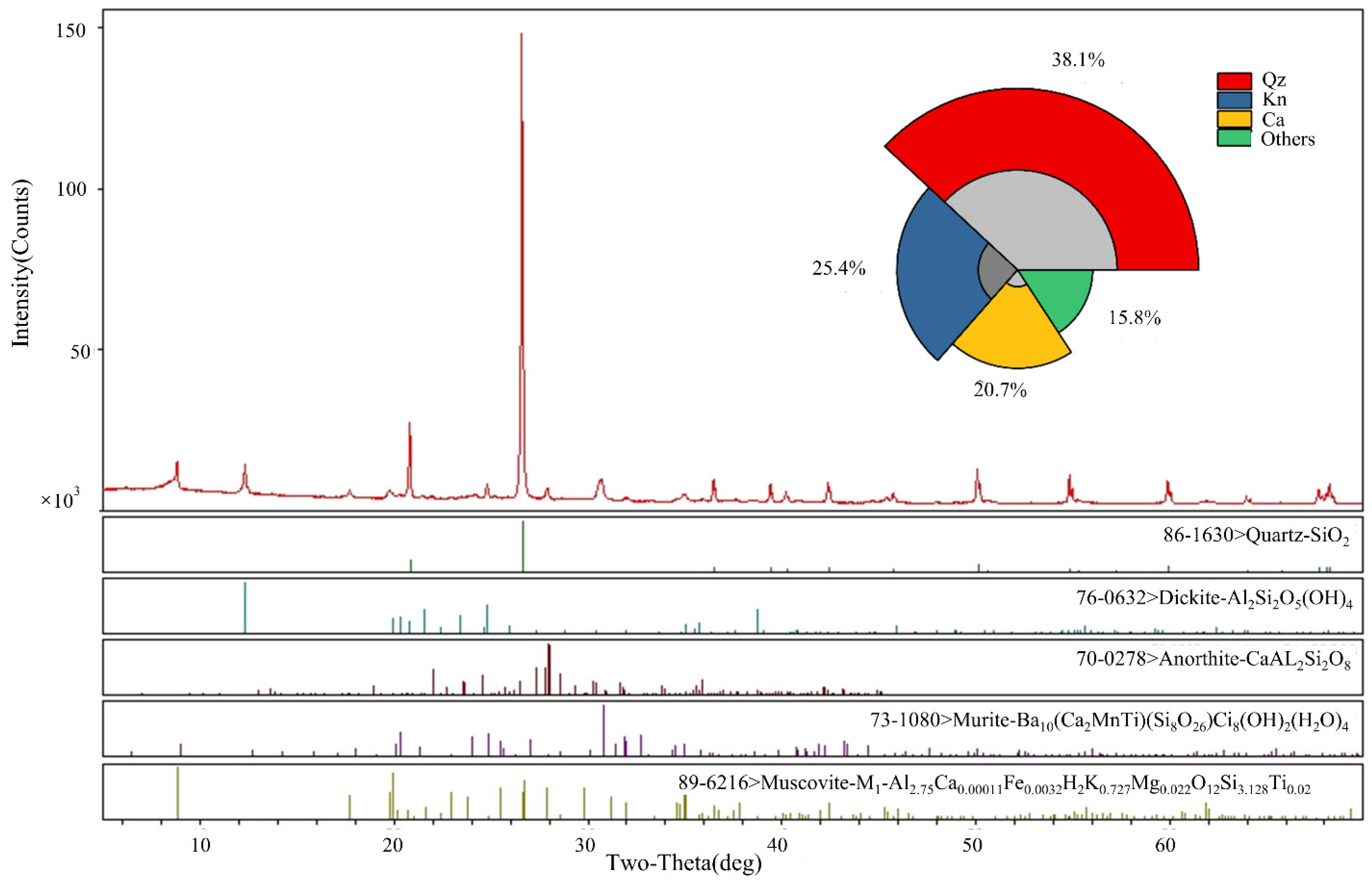
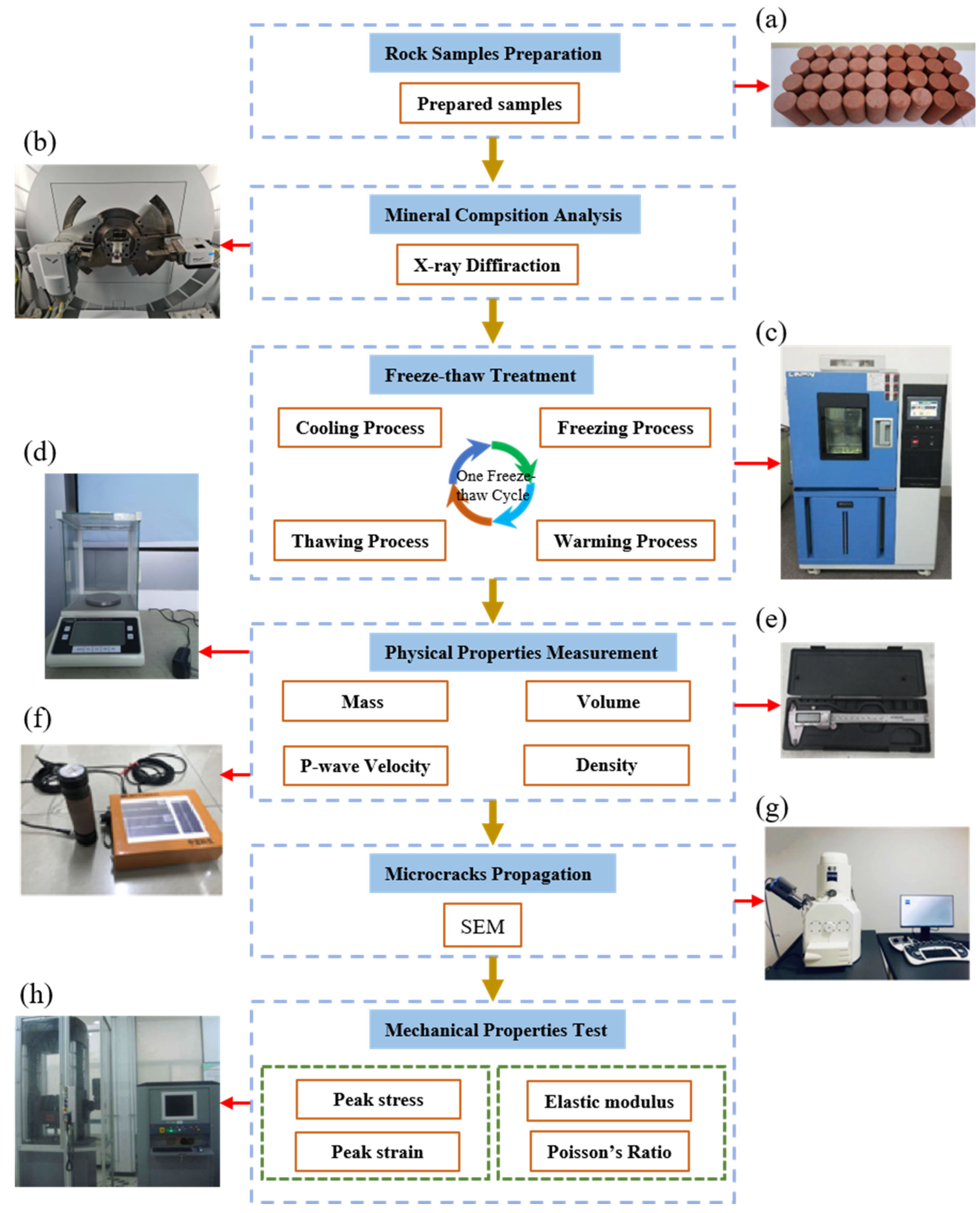

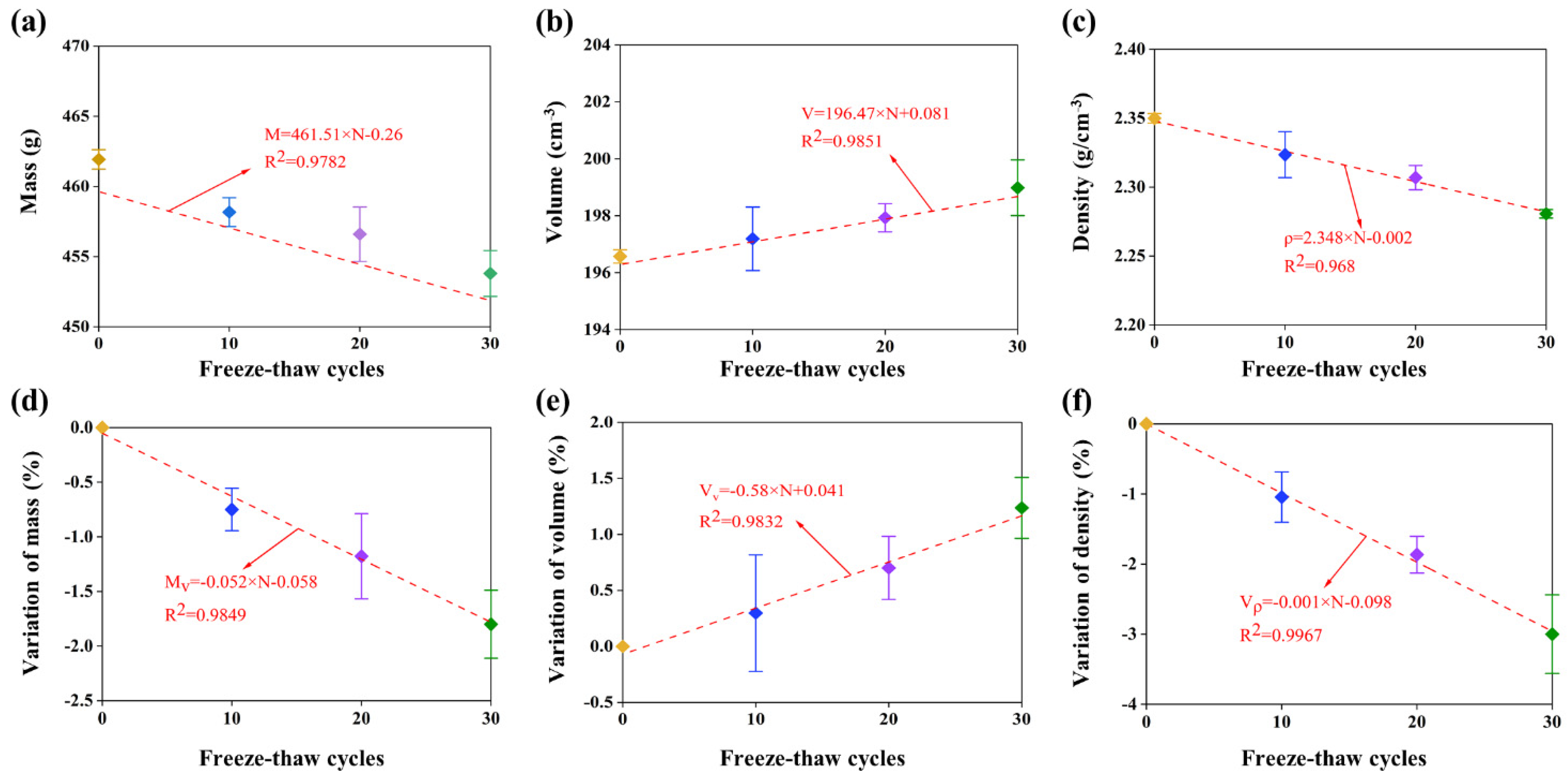

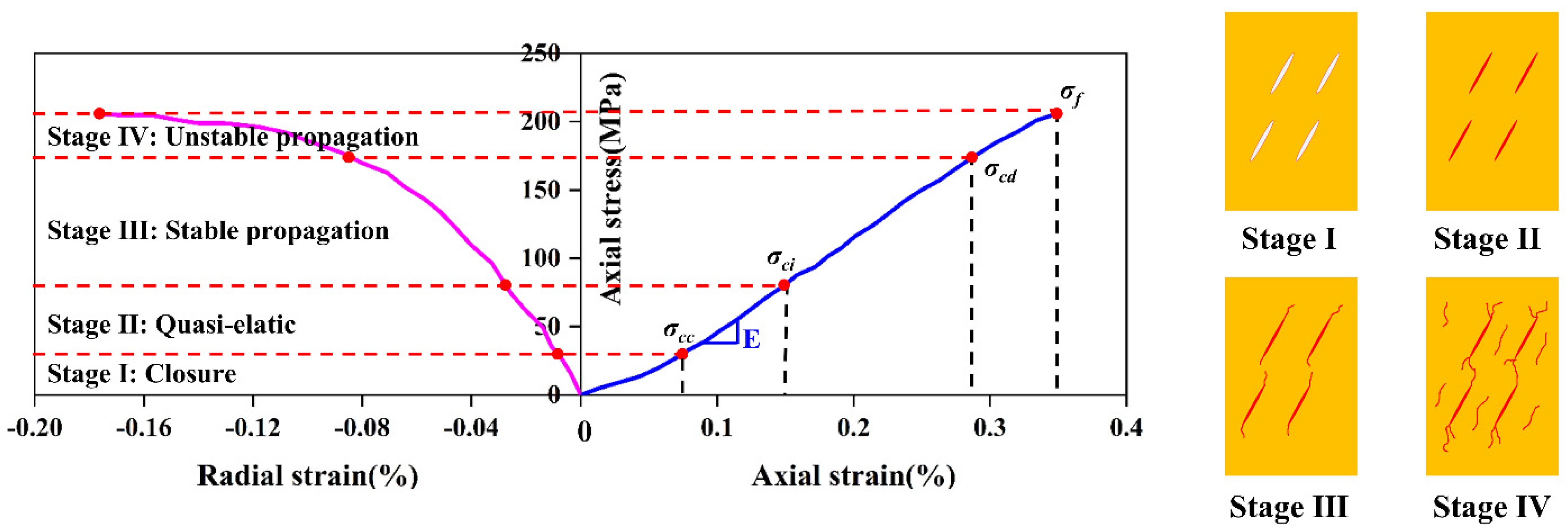
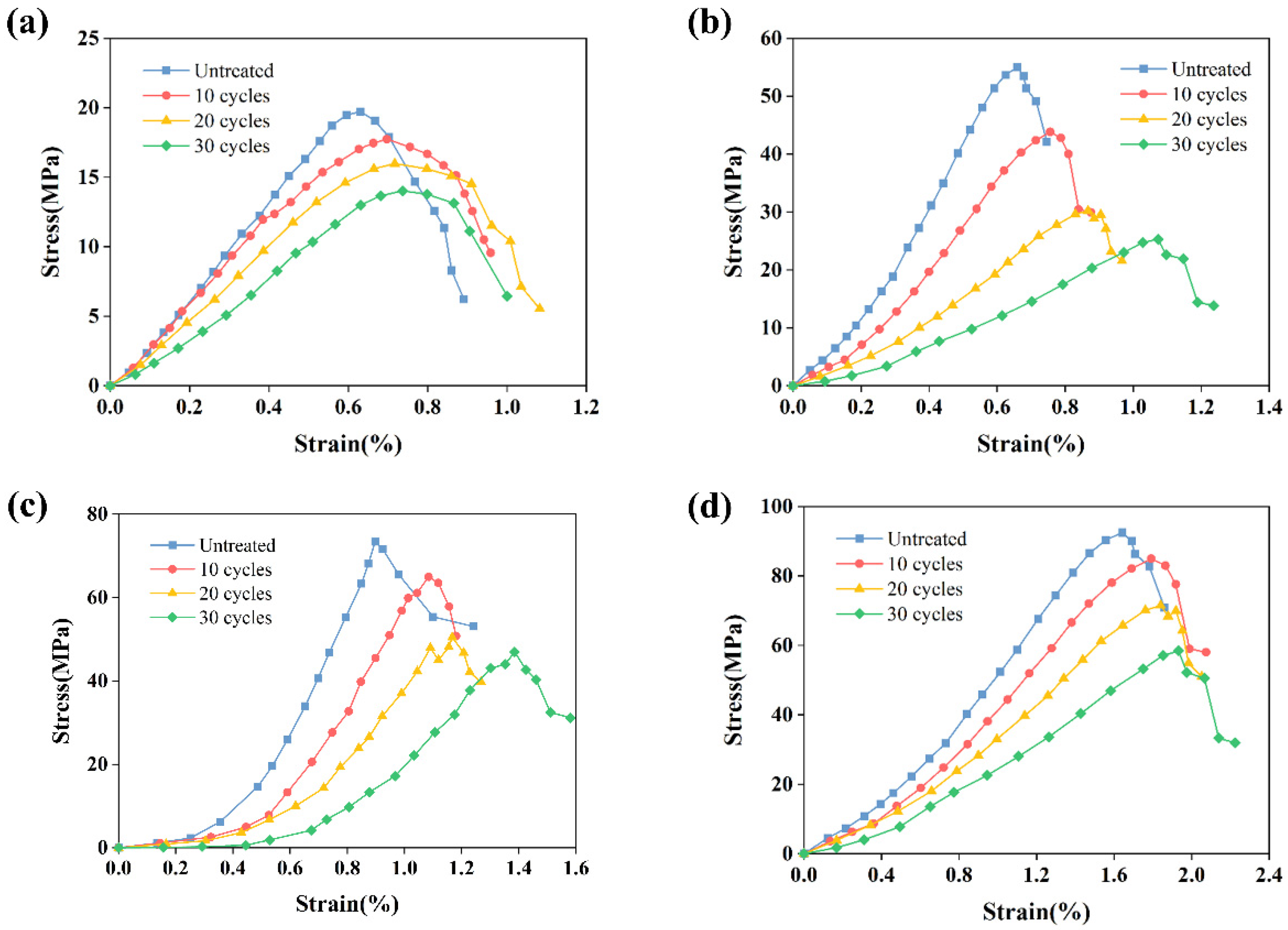

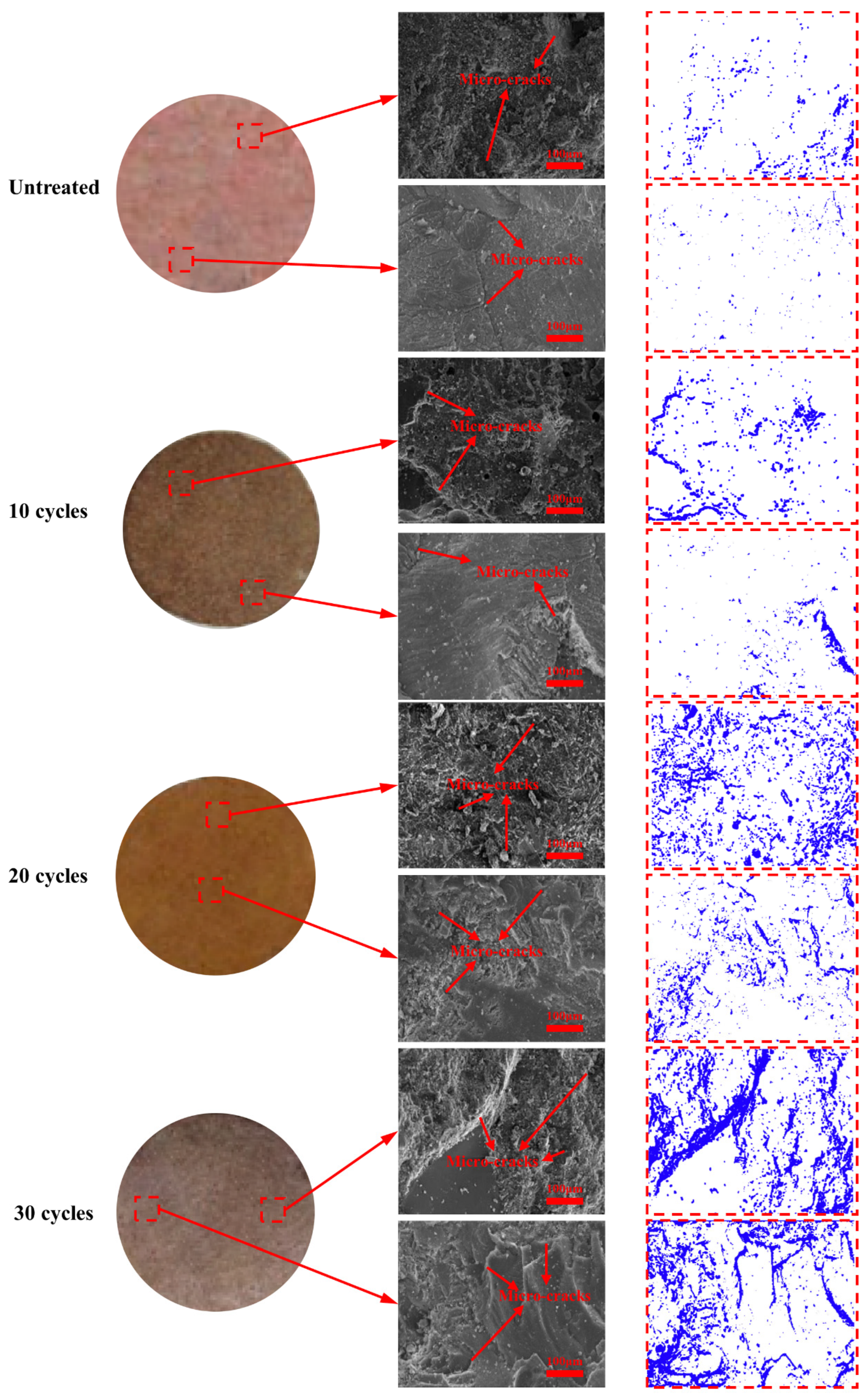
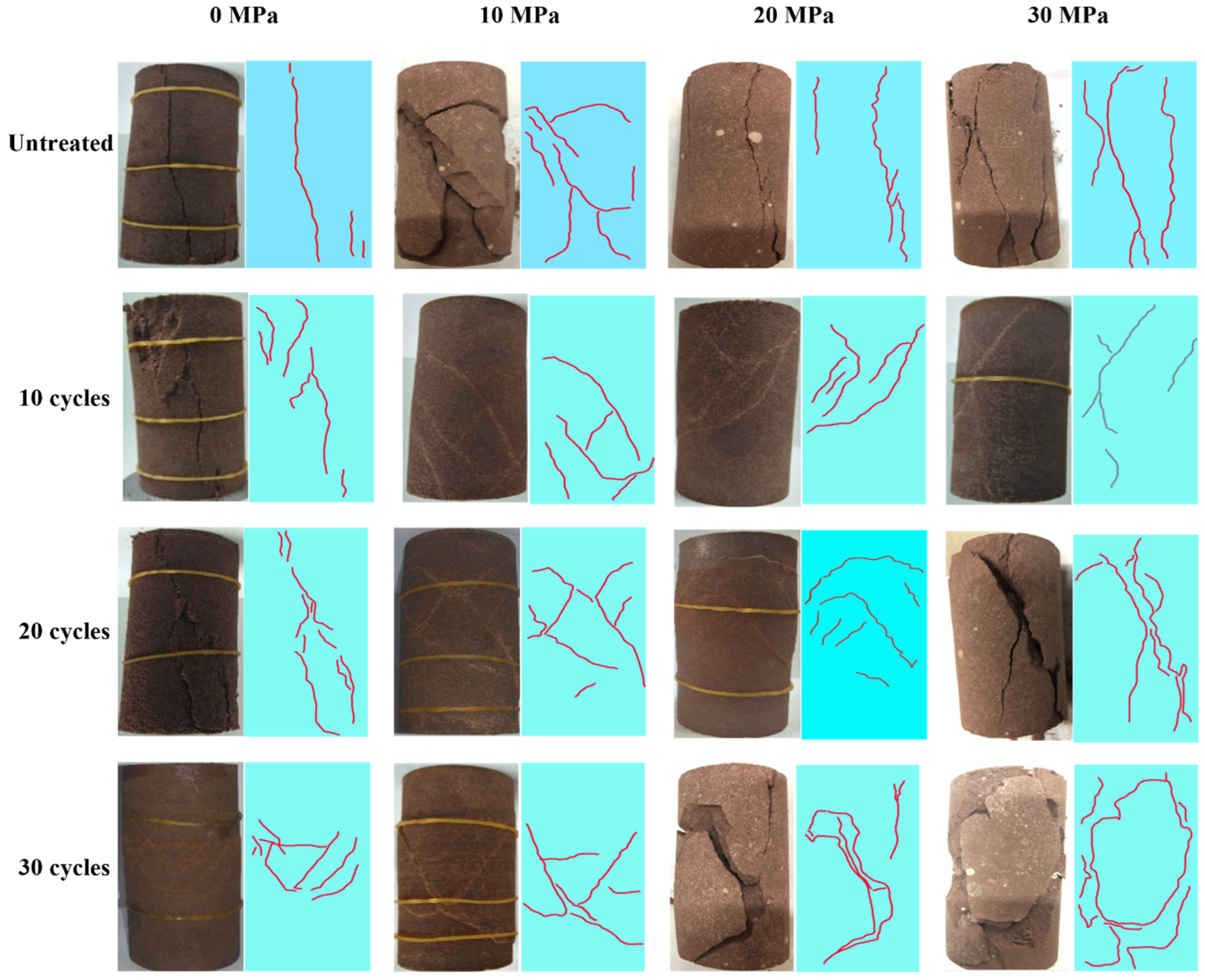
| Size | Mass (g) | Density (g/cm3) | P-Wave Velocity (m/s) | |
|---|---|---|---|---|
| Length (mm) | Diameter (mm) | |||
| 100 ± 0.3 | 50 ± 0.2 | 461.18 ± 5.24 | 2.3496 ± 0.0113 | 2077.65 ± 3.54 |
| Freeze-Thaw Cycles | Mass | Volume | Density | ||||||
|---|---|---|---|---|---|---|---|---|---|
| Before (g) | After (g) | Variation (%) | Before (cm3) | After (cm3) | Variation (%) | Before | After (g/cm3) | Variation (%) | |
| 10 | 462.48 | 458.63 | −0.83 | 196.67 | 196.78 | 0.06 | 2.3516 | 2.3307 | −0.89 |
| 461.49 | 458.07 | −0.74 | 196.81 | 197.67 | 0.44 | 2.3449 | 2.3173 | −1.17 | |
| 460.94 | 457.82 | −0.68 | 196.34 | 197.12 | 0.40 | 2.3477 | 2.3225 | −1.07 | |
| 20 | 461.94 | 456.91 | −1.09 | 196.84 | 198.16 | 0.67 | 2.3468 | 2.3058 | −1.75 |
| 463.48 | 457.18 | −1.36 | 196.65 | 197.84 | 0.61 | 2.3569 | 2.3109 | −1.95 | |
| 460.71 | 455.71 | −1.09 | 196.17 | 197.79 | 0.83 | 2.3485 | 2.3040 | −1.90 | |
| 30 | 461.59 | 453.94 | −1.66 | 196.86 | 199.05 | 1.11 | 2.3448 | 2.2805 | −2.74 |
| 462.94 | 454.37 | −1.85 | 196.74 | 199.34 | 1.32 | 2.3531 | 2.2794 | −3.13 | |
| 461.82 | 453.08 | −1.89 | 196.06 | 198.56 | 1.28 | 2.3555 | 2.2818 | −3.13 | |
| Freeze-Thaw Cycles | Testing Value (m/s) | Mean Value (m/s) | Absolute Deviation | Relative Deviation (%) | Standard Deviation (m/s) | Coefficient of Variation (%) |
|---|---|---|---|---|---|---|
| 0 | 2083.48 | 2075.09 | 8.3867 | 0.4042 | 4.4231 | 0.2132 |
| 2076.84 | 1.7467 | 0.0842 | ||||
| 2064.96 | 10.1333 | 0.4883 | ||||
| 10 | 1932.49 | 1917.11 | 15.3833 | 0.8024 | 8.0683 | 0.4209 |
| 1898.67 | 18.4367 | 0.9617 | ||||
| 1920.16 | 3.0533 | 0.1593 | ||||
| 20 | 1824.91 | 1805.79 | 19.1200 | 1.0588 | 8.8263 | 0.4888 |
| 1804.97 | 0.8200 | 0.0454 | ||||
| 1787.49 | 18.3000 | 1.0134 | ||||
| 30 | 1756.84 | 1732.41 | 24.4400 | 1.4108 | 12.0971 | 0.6983 |
| 1705.67 | 26.7300 | 1.5429 | ||||
| 1734.69 | 2.2900 | 0.1322 |
| Confining Pressure (MPa) | Untreated | 10 Cycles | 20 Cycles | 30 Cycles | ||||||||||||
|---|---|---|---|---|---|---|---|---|---|---|---|---|---|---|---|---|
| Σ (MPa) | Ε (%) | E (GPa) | λ | Σ (MPa) | Ε (%) | E (GPa) | λ | Σ (MPa) | Ε (%) | E (GPa) | λ | Σ (MPa) | Ε (%) | E (GPa) | λ | |
| 0 | 19.74 | 0.631 | 3.12 | 0.18 | 17.64 | 0.697 | 2.76 | 0.23 | 15.97 | 0.717 | 2.13 | 0.28 | 13.97 | 0.736 | 1.89 | 0.34 |
| 10 | 54.95 | 0.659 | 7.34 | 0.37 | 43.84 | 0.756 | 6.49 | 0.43 | 30.19 | 0.867 | 5.87 | 0.49 | 25.31 | 1.067 | 5.06 | 0.53 |
| 20 | 73.46 | 0.897 | 9.94 | 0.41 | 64.97 | 1.084 | 8.86 | 0.48 | 50.43 | 1.167 | 8.06 | 0.53 | 46.97 | 1.385 | 7.59 | 0.59 |
| 30 | 92.49 | 1.64 | 12.84 | 0.55 | 84.97 | 1.79 | 11.54 | 0.58 | 71.49 | 1.84 | 10.97 | 0.61 | 58.49 | 1.93 | 10.34 | 0.67 |
| Micro-Cracks | Pores | |||||
|---|---|---|---|---|---|---|
(μm) | (μm) | (μm) | (μm) | (μm) | (μm) | |
| Untreated | 60.64 | 19.4 | 4.6 | 2.3 | 4.2 | 2.7 |
| 10 cycles | 167.6 | 40.6 | 10.3 | 9.3 | 7.9 | 5.6 |
| 20 cycles | 206.7 | 53.7 | 18.7 | 11.8 | 11.5 | 7.2 |
| 30 cycles | 281.4 | 70.8 | 31.5 | 14.6 | 15.4 | 11.1 |
Publisher’s Note: MDPI stays neutral with regard to jurisdictional claims in published maps and institutional affiliations. |
© 2022 by the authors. Licensee MDPI, Basel, Switzerland. This article is an open access article distributed under the terms and conditions of the Creative Commons Attribution (CC BY) license (https://creativecommons.org/licenses/by/4.0/).
Share and Cite
Zhang, X.-W.; Xu, J.-H.; Cao, Y.; Sun, L.; Shaikh, F. Experimental Investigation on Fracture Behavior and Mechanical Properties of Red Sandstone Subjected to Freeze–Thaw Cycles. Sustainability 2022, 14, 14155. https://doi.org/10.3390/su142114155
Zhang X-W, Xu J-H, Cao Y, Sun L, Shaikh F. Experimental Investigation on Fracture Behavior and Mechanical Properties of Red Sandstone Subjected to Freeze–Thaw Cycles. Sustainability. 2022; 14(21):14155. https://doi.org/10.3390/su142114155
Chicago/Turabian StyleZhang, Xiao-Wu, Jin-Hai Xu, Yue Cao, Lei Sun, and Faiz Shaikh. 2022. "Experimental Investigation on Fracture Behavior and Mechanical Properties of Red Sandstone Subjected to Freeze–Thaw Cycles" Sustainability 14, no. 21: 14155. https://doi.org/10.3390/su142114155
APA StyleZhang, X.-W., Xu, J.-H., Cao, Y., Sun, L., & Shaikh, F. (2022). Experimental Investigation on Fracture Behavior and Mechanical Properties of Red Sandstone Subjected to Freeze–Thaw Cycles. Sustainability, 14(21), 14155. https://doi.org/10.3390/su142114155





